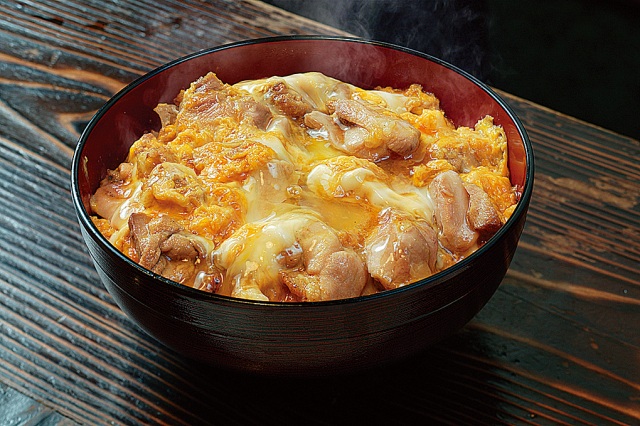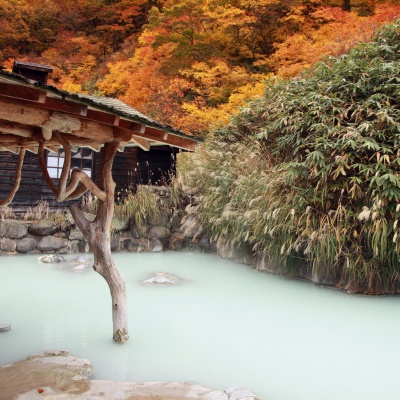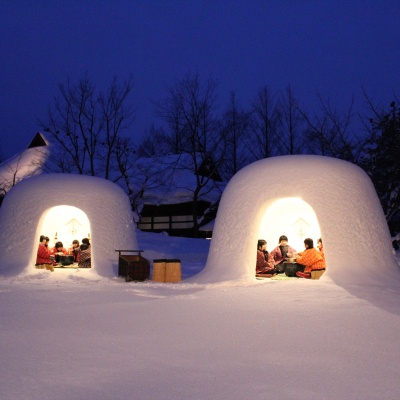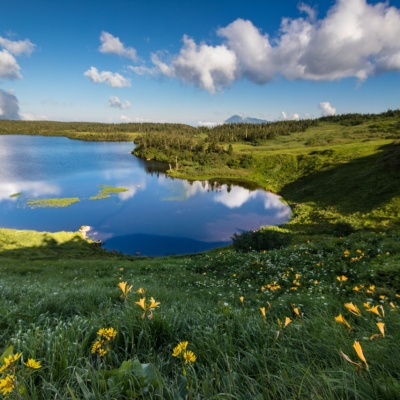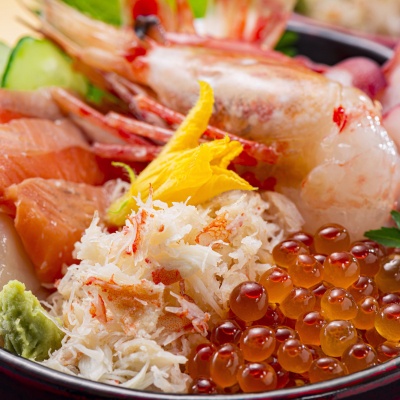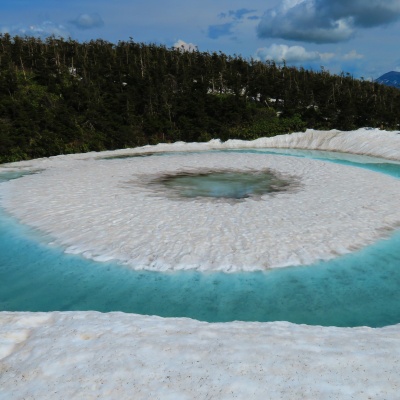3 Day Trip to Iwate and Akita: Nature & Hot Springs
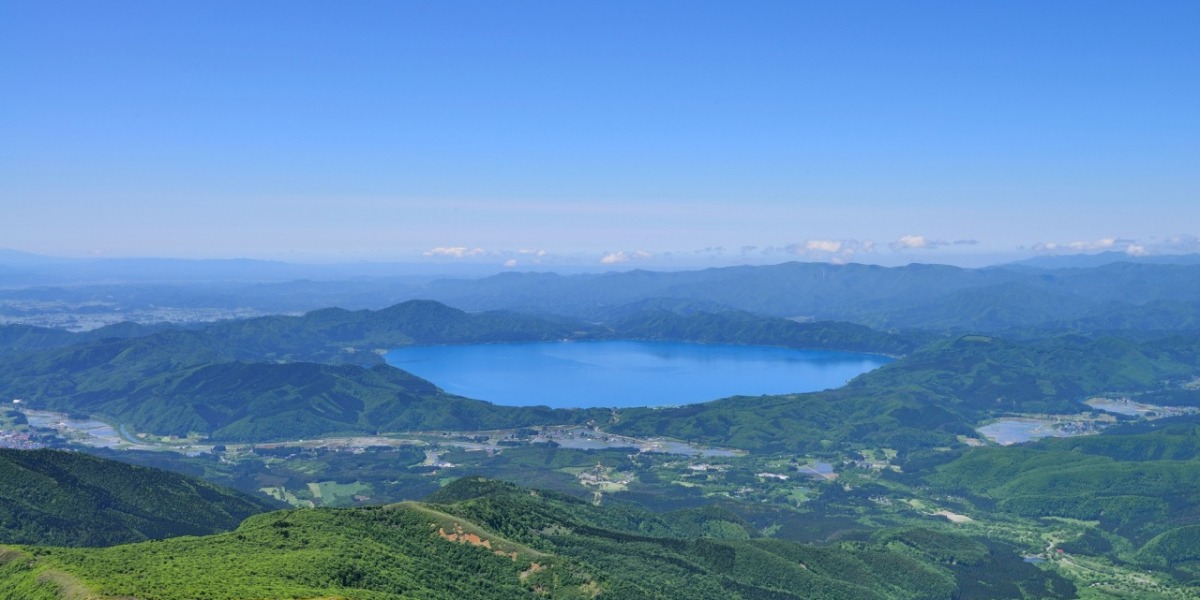
Akita and Iwate can be found towards the northern part of Tohoku and share a border along the Towada-Hachimantai National Park.
This course starts not far from Morioka Station, which can be reached in two and a half hours from Tokyo.
START
Day1
Koiwai Farm
Recharge your batteries in this massive farmland backed by stunning views of Mount Iwate!
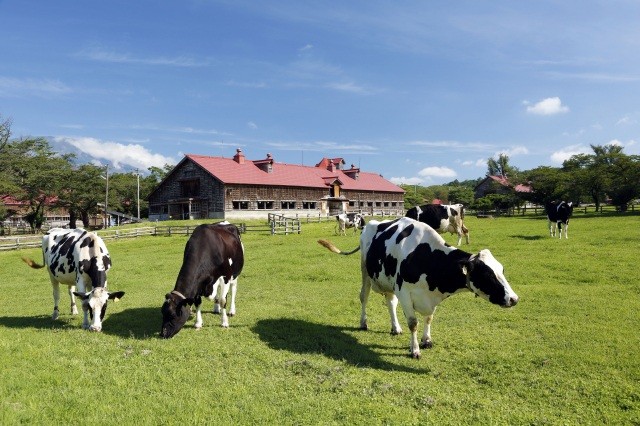
Koiwai Farm, one of the largest private integrated farms in Japan with a history of over 130 years since its establishment in 1891, has a total area of 3,000 hectares, part of which is open to the public as "Makibaen. Beyond the vast grassy plains, the majestic Mt.The farm also offers a variety of hands-on programs, including guided tours of the farm's forests, which are normally off-limits to the public.In addition, 21 buildings, including cowsheds and silos, designated as national important cultural properties, many of which are still in use today, can be viewed up close, including nine in the Kamimaru cowshed. The rest can be experienced at the Koiwai Farm Important Cultural Property Gallery, which makes full use of the latest digital technology in the park.
Food is also an important part of the Makibaen experience. Restaurants and snack stores offer dishes and sweets made with ingredients produced on the farm. Be sure to try the soft-serve ice cream made from raw milk from the Kamimaru Cowshed.
One of the largest illumination events in Tohoku is held during the winter season, offering a different view of the farm than during the daytime.
The farm is also famous for its lone cherry tree in full bloom against the backdrop of majestic Mt.
Food is also an important part of the Makibaen experience. Restaurants and snack stores offer dishes and sweets made with ingredients produced on the farm. Be sure to try the soft-serve ice cream made from raw milk from the Kamimaru Cowshed.
One of the largest illumination events in Tohoku is held during the winter season, offering a different view of the farm than during the daytime.
The farm is also famous for its lone cherry tree in full bloom against the backdrop of majestic Mt.
Tsunagi Onsen
A popular hot spring on the outskirts of Morioka, discovered by the famous warrior Minamoto no Yoshiie
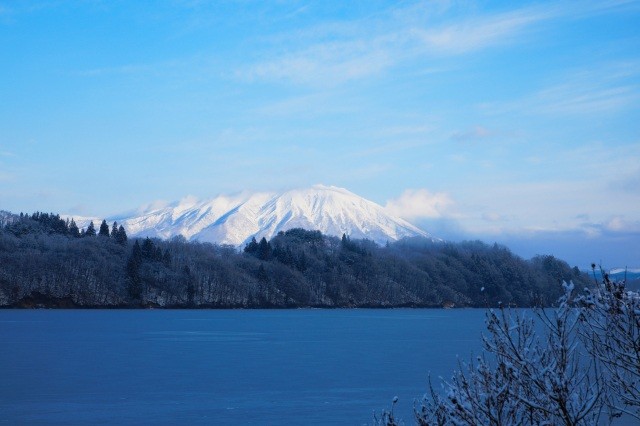
Tsunagi Onsen is located near Lake Gosho, a popular scenic location with views of Mount Iwaki and the impressive Tsunagi Bridge spanning the breadth of the lake.
With a history stretching back 900 years, Tsunagi Onsen is a popular hot spring on the outskirts of Morioka. The Onsen was named “Tsunagi” (tether) from when the famous samurai warrior Minamoto no Yoshiie took a bath while his horse was tied to a stone. The stone came to be known as Tsunagi Stone and can now be seen at the Tsunagi Onsen Shrine. The alkaline hot spring water is rich in metasilicic acid, a natural moisturiser, and is known to promote beautiful skin by removing waste products from the body and making the skin smooth.
Tsunagi Onsen is a 30-minute drive from Morioka station. Along with the nearby Koiwai Farm and Morioka Tezukuri Mura arts and crafts centre, the Onsen offers easy access to local attractions including Lake Towada, Mount Hachimantai, Kakunodate, Jodogahama Beach and Hiraizumi. The Onsen offers a wide range of hot spring inns suitable for all visitors and is the perfect location to stay while travelling around Northern Tohoku.
Visitors can enjoy the seasonal scenery of Lake Gosho with springtime cherry blossoms, verdant summer greens, vibrant autumn leaves and snowy winter scenes. The fireworks display over the lake during the summer festival is particularly spectacular.
With a history stretching back 900 years, Tsunagi Onsen is a popular hot spring on the outskirts of Morioka. The Onsen was named “Tsunagi” (tether) from when the famous samurai warrior Minamoto no Yoshiie took a bath while his horse was tied to a stone. The stone came to be known as Tsunagi Stone and can now be seen at the Tsunagi Onsen Shrine. The alkaline hot spring water is rich in metasilicic acid, a natural moisturiser, and is known to promote beautiful skin by removing waste products from the body and making the skin smooth.
Tsunagi Onsen is a 30-minute drive from Morioka station. Along with the nearby Koiwai Farm and Morioka Tezukuri Mura arts and crafts centre, the Onsen offers easy access to local attractions including Lake Towada, Mount Hachimantai, Kakunodate, Jodogahama Beach and Hiraizumi. The Onsen offers a wide range of hot spring inns suitable for all visitors and is the perfect location to stay while travelling around Northern Tohoku.
Visitors can enjoy the seasonal scenery of Lake Gosho with springtime cherry blossoms, verdant summer greens, vibrant autumn leaves and snowy winter scenes. The fireworks display over the lake during the summer festival is particularly spectacular.
Day2
Samurai District
Travel back in time to the Edo period in the “Little Kyoto of Tohoku”!
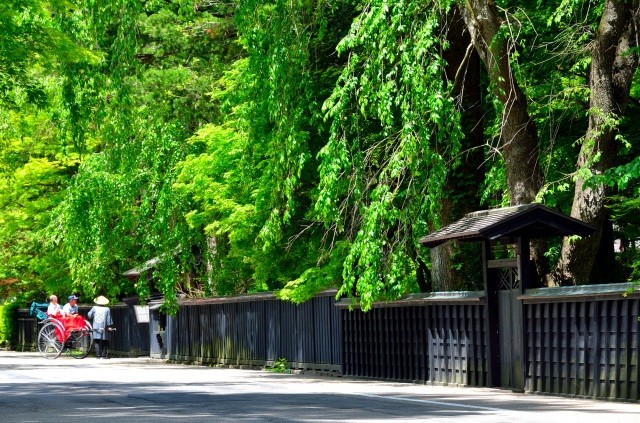
Kakunodate is a former castle town which flourished during the Edo period. Known as the “Little Kyoto of Tohoku”, the town is home to a district two-kilometres in radius consisting of samurai residences and traditional architecture popular with both domestic and international tourists. The samurai residences lining the town’s most famous street are nationally protected Traditional Buildings.
Though some of them are still functioning homes, the residences are open to the public so visitors can get a feel for the traditional samurai life. Tourists can travel back in time to the Edo period by strolling around the traditional streets in an antique Kimono from one of the rental stores in town! A rickshaw ride from the Kakunodate Denshokan Museum will enhance the experience.
The town is charming throughout the year with springtime cherry blossoms, verdant summer greens, colourful autumn leaves and snowy winter scenes. Springtime is particularly popular with people coming for cherry blossom viewing from late April to early May. The traditional district features a row of weeping cherry blossom trees whose pink flowers bloom in beautiful contrast with the black walls of samurai residences, 162 of the 400 weeping cherry trees are designated natural treasures.
The samurai district is a 15 to 20-minute walk from JR Kakunodate station. Be sure to pick up the handy map and brochures available at the tourist information centre, located in a building resembling a traditional storehouse in front of the station!
A thematic journey in the Tohoku region:Castles・SamuraiA thematic journey in the Tohoku region:Flowers
Though some of them are still functioning homes, the residences are open to the public so visitors can get a feel for the traditional samurai life. Tourists can travel back in time to the Edo period by strolling around the traditional streets in an antique Kimono from one of the rental stores in town! A rickshaw ride from the Kakunodate Denshokan Museum will enhance the experience.
The town is charming throughout the year with springtime cherry blossoms, verdant summer greens, colourful autumn leaves and snowy winter scenes. Springtime is particularly popular with people coming for cherry blossom viewing from late April to early May. The traditional district features a row of weeping cherry blossom trees whose pink flowers bloom in beautiful contrast with the black walls of samurai residences, 162 of the 400 weeping cherry trees are designated natural treasures.
The samurai district is a 15 to 20-minute walk from JR Kakunodate station. Be sure to pick up the handy map and brochures available at the tourist information centre, located in a building resembling a traditional storehouse in front of the station!
A thematic journey in the Tohoku region:Castles・SamuraiA thematic journey in the Tohoku region:Flowers
Lunch at around Kakunodate
Lake Tazawa
Get spiritual at Japan’s deepest lake with mysterious cobalt blue water!
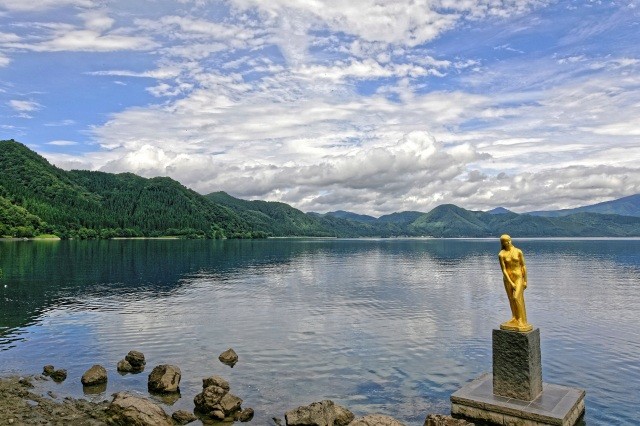
Lake Tazawa (Tazawako) is a stunning lake in Akita and has been selected as one of the 100 most scenic spots in Japan.
It is the deepest lake in Japan, with a depth of 423.4 meters. The surface of the lake changes from brilliant lapis lazuli to azure to indigo and is worth seeing. Take a cruise on a sightseeing boat, or take a paddle boat, canoe, kayak, SUP to enjoy the waters of the lake. It is also worth cycling, trekking, or driving along the lakeside to see the colors change across the lake. For those who want to stay longer, set up camp and see the changes with the time of day.
The Statue of Tatsuko is a golden female statue which stands against the backdrop of this magnificent lake. It is a famous spot by Lake Tazawa erected based on a legend that once upon a time, a girl named Tatsuko, who wished to keep her beauty forever, turned into a dragon and threw herself into Lake Tazawa. But there is more to this legend. In Hachirogata, or Hachiro Lagoon, there was a man named Hachiro Taro transformed into a dragon, and he fell in love with Tatsuko. As the two began to live together in Lake Tazawa, the lake became deeper and deeper without freezing in winter. In contrast, Hachiro Lagoon became shallower and shallower with each passing year when its master disappeared.
There are three statues associated with the Tatsuko Legend; the others being Tatsuko Kannon on the east shore of the lake and Tatsuko Hime (Princess Tatsuko) on the grounds of the Gozanoishi Shrine. Ukiki Shrine, located right next to the Statue of Tatsuko, is a power spot for marriage. Gozanoishi Shrine, which enshrines Tatsuko Hime no Kami as its main deity, is said to be bring beauty. The red torii gate is a popular photo spot.
It is the deepest lake in Japan, with a depth of 423.4 meters. The surface of the lake changes from brilliant lapis lazuli to azure to indigo and is worth seeing. Take a cruise on a sightseeing boat, or take a paddle boat, canoe, kayak, SUP to enjoy the waters of the lake. It is also worth cycling, trekking, or driving along the lakeside to see the colors change across the lake. For those who want to stay longer, set up camp and see the changes with the time of day.
The Statue of Tatsuko is a golden female statue which stands against the backdrop of this magnificent lake. It is a famous spot by Lake Tazawa erected based on a legend that once upon a time, a girl named Tatsuko, who wished to keep her beauty forever, turned into a dragon and threw herself into Lake Tazawa. But there is more to this legend. In Hachirogata, or Hachiro Lagoon, there was a man named Hachiro Taro transformed into a dragon, and he fell in love with Tatsuko. As the two began to live together in Lake Tazawa, the lake became deeper and deeper without freezing in winter. In contrast, Hachiro Lagoon became shallower and shallower with each passing year when its master disappeared.
There are three statues associated with the Tatsuko Legend; the others being Tatsuko Kannon on the east shore of the lake and Tatsuko Hime (Princess Tatsuko) on the grounds of the Gozanoishi Shrine. Ukiki Shrine, located right next to the Statue of Tatsuko, is a power spot for marriage. Gozanoishi Shrine, which enshrines Tatsuko Hime no Kami as its main deity, is said to be bring beauty. The red torii gate is a popular photo spot.
Stay one night in Nyuto Onsenkyo
These seven hidden hot springs nestled in the mountains are a must visit!
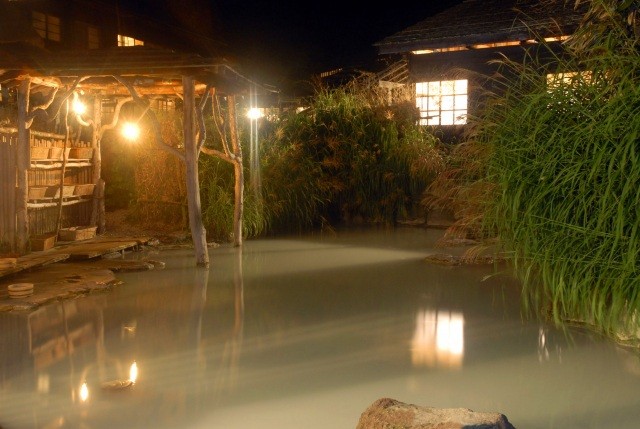
Nyuto Onsenkyo is a hot spring town famous throughout Japan for its hidden hot springs. The area consists of seven hot spring resorts, each with its own unique hot spring source. Since there is a wide variety of spring qualities and inns, it is recommended to enjoy each one by visiting the various hot spring baths.
For 600 yen, you can purchase a Yumeguri Map for unlimited rides on the Yumeguri-go bus that circles around Nyuto Onsenkyo for one day, making it a convenient way to get around. Guests can purchase a Yumeguri-cho booklet for 1,800 yen, which includes bathing fees for the seven hot springs. Both are available at the front desk of each inn.
For 600 yen, you can purchase a Yumeguri Map for unlimited rides on the Yumeguri-go bus that circles around Nyuto Onsenkyo for one day, making it a convenient way to get around. Guests can purchase a Yumeguri-cho booklet for 1,800 yen, which includes bathing fees for the seven hot springs. Both are available at the front desk of each inn.
Day3
Senshu Park
Autumn leaves of Kubota Castle
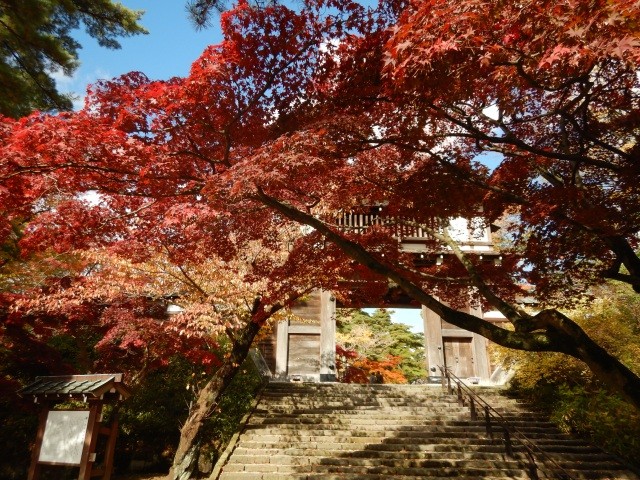
Senshu Park is the site of the 200,000 stone castle of Satake of the Akita Domain and is also a stunning location when the autumn leaves are in full bloom from mid-October to early November. <br> From here you can enjoy views of Akita City from the observation room of the Osumi-Yagura turret. Check out the view with Kubota Castle Front Gate and the Satake Historical Material Museum for a memorable autumn view.
Lunch in Akita city
Inaniwa Udon Noodles
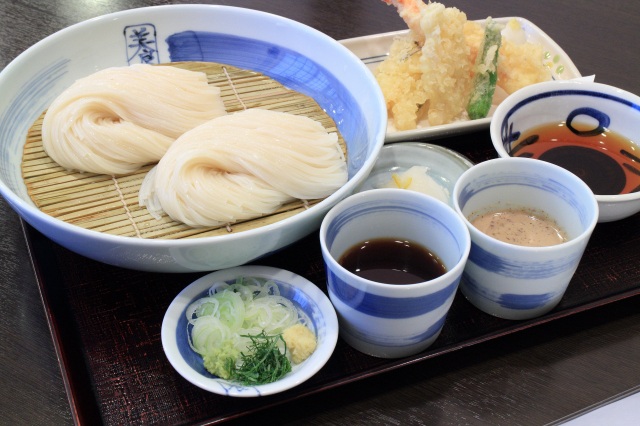
Inaniwa-cho in the city of Yuzawa in Akita prefecture is the hometown of Inaniwa Udon noodles. The smooth, chewy noodles are hand-made using the traditional processes of kneading, pounding and stretching. Praised nationally as one of Japan’s three best noodles, Inaniwa Udon was used as a traditional offering to landlords and as gifts between feudal lords travelling to and from Edo (Tokyo) during the Edo period. In addition to the city of Yuzawa, there are a number of restaurants throughout Akita offering popular Inaniwa Udon.
Search Restaurants
Search Restaurants
Ogashinzan Folklore Museum
The traditional folk event "Namahage of Oga" demonstration is so powerful!
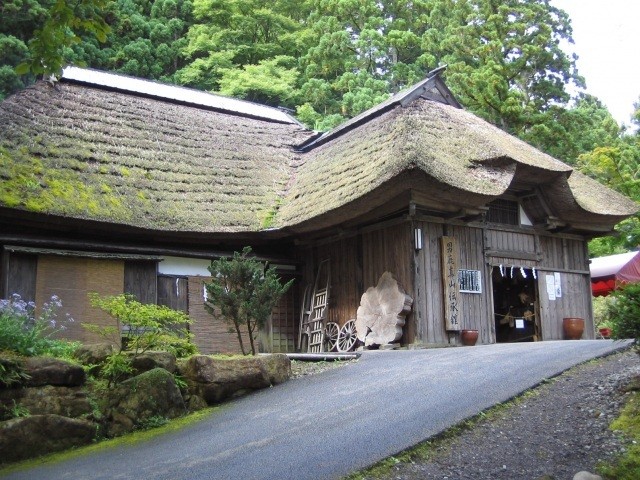
“Namahage” is a folk ritual performed throughout the Oga Peninsula and surrounding areas. Each New Year’s Eve fierce demons known as Namahage visit each house to frighten misbehaved children. Despite their scary appearance, the Namahage are gods bringing the local people warnings against laziness as well as blessings for the wellbeing of their families and rich harvests from the mountains and the sea for the coming year.
The Ogashinzan Folklore Museum gives visitors the chance to learn about and experience the Namahage folklore tradition. The museum is in a traditional thatched-roof farmhouse known as Magariya (“bent house”) connected in an L-shape with a horse stable. Visitors seat themselves in the tatami-floored room beside a traditional “Irori” fireplace while listening to an explanation of the Namahage and viewing a live performance.
The fierce Namahage, stomping around the room and crying out for badly behaved children, are vigorous and frightening. Be sure to collect some of the fallen straw from the Namahage’s costumes which is said to be a charm against evil spirits. Please don’t pull at the costumes too forcefully though!
The nearby Namahage Museum offers a variety of displays on the Namahage and offers visitors the chance to dress-up in a Namahage costume. Enjoy discovering the folk culture of Namahage, officially recognised as a UNESCO Intangible Cultural Heritage!
The Ogashinzan Folklore Museum gives visitors the chance to learn about and experience the Namahage folklore tradition. The museum is in a traditional thatched-roof farmhouse known as Magariya (“bent house”) connected in an L-shape with a horse stable. Visitors seat themselves in the tatami-floored room beside a traditional “Irori” fireplace while listening to an explanation of the Namahage and viewing a live performance.
The fierce Namahage, stomping around the room and crying out for badly behaved children, are vigorous and frightening. Be sure to collect some of the fallen straw from the Namahage’s costumes which is said to be a charm against evil spirits. Please don’t pull at the costumes too forcefully though!
The nearby Namahage Museum offers a variety of displays on the Namahage and offers visitors the chance to dress-up in a Namahage costume. Enjoy discovering the folk culture of Namahage, officially recognised as a UNESCO Intangible Cultural Heritage!
Namahage Museum
The collection of 150 hand-carved Namahage masks is a must see! Enjoy dressing up in a real Namahage costume!
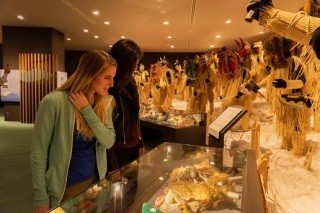
Namahage is a traditional folk event on the Oga Peninsula. Namahage wears an ogre mask and cries out, "Are there any crying children?" and is mistaken for a bad guy who makes children cry.In truth, however, he is a god who comes every New Year's Eve to warn people against laziness and to bring good health, good harvest in the fields, good harvest in the mountains, and good harvest in the sea.
The Namahage Museum introduces the history and culture of Namahage. The Namahage display corner features 150 diverse masks that were actually used in each village. In the Lore Hall, the movie "One Night of Namahage," which introduces the Namahage culture on New Year's Eve, is shown.
There is a corner where visitors can dress up in Namahage costumes and have their picture taken, and a souvenir corner where Namahage goods can be purchased. If you are lucky, you can watch a Namahage carver demonstrate hand-carving masks. (This event is held irregularly).
Next to the Namahage Museum is the Oga Mayama Folklore Museum, where Namahage demonstrations can be seen. Visit both and enjoy the Namahage, which has been registered as a UNESCO Intangible Cultural Heritage.
The Namahage Museum introduces the history and culture of Namahage. The Namahage display corner features 150 diverse masks that were actually used in each village. In the Lore Hall, the movie "One Night of Namahage," which introduces the Namahage culture on New Year's Eve, is shown.
There is a corner where visitors can dress up in Namahage costumes and have their picture taken, and a souvenir corner where Namahage goods can be purchased. If you are lucky, you can watch a Namahage carver demonstrate hand-carving masks. (This event is held irregularly).
Next to the Namahage Museum is the Oga Mayama Folklore Museum, where Namahage demonstrations can be seen. Visit both and enjoy the Namahage, which has been registered as a UNESCO Intangible Cultural Heritage.
GOAL
